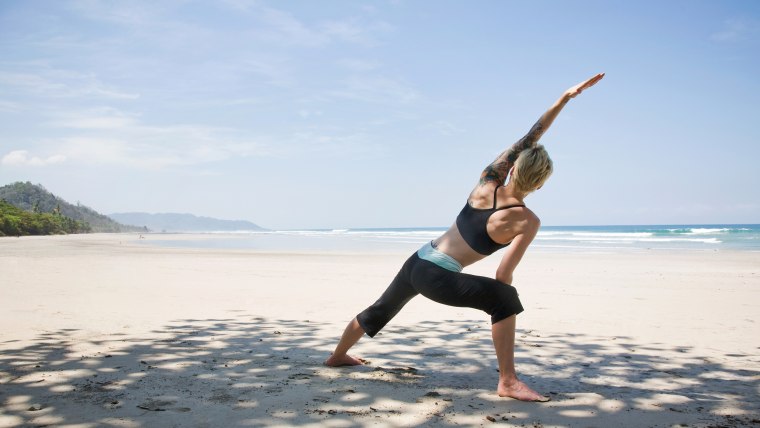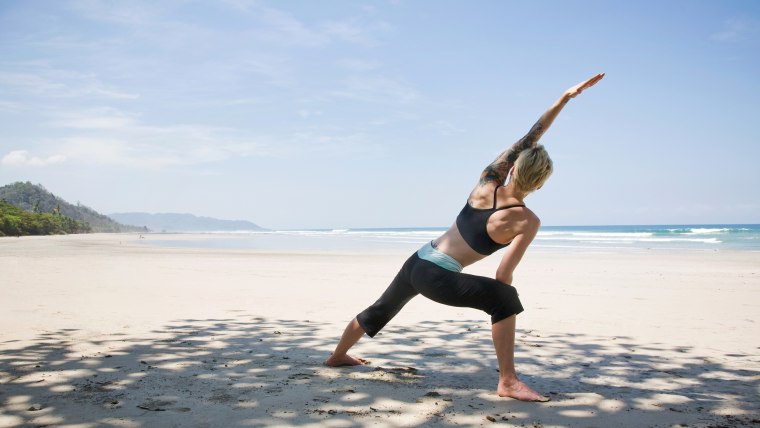
Trouble sleeping? You are not alone. According to the National Center on Sleep Disorders Research, 70 million Americans have sleep problems and 60 percent of those people suffer from chronic sleep issues. It’s no surprise then that each year millions of sleep aids are prescribed. These medications often have negative side effects, and the sleep problems return as soon as you stop taking the medication. They do nothing to help the underlying problems, which are often due to anxiety, stress and fatigue. Here’s another way to tackle sleep issues without medication — practice yoga before bedtime.
You might think that a vigorous physical practice would be the best approach — beating your body into submission until you rest out of sheer exhaustion. But that would be incorrect. A vigorous yoga practice is a wonderful way to get you going in the morning, or even to give yourself a boost in the afternoon. However, intense activity less than 4 hours before bedtime can actually hinder your ability to wind down. In fact, it may leave you feeling wired, which is a sign that you’re overtired.
To use yoga as an effective sleep aid, practice gently and slowly. Slowing down helps your body and mind integrate and process the events of the day. The most useful tool you have to combat sleep problems is your breath. Taking time to breathe deeply into the belly, slowing down your heart and your mind, is a huge piece of this work.
How to Begin A Relaxing Yoga Practice: Breathe
Take some deep breaths in and let out long sighs and yawns. As you breathe deeply into the belly and in and out through your nose, begin to exaggerate your exhalation. Allow your exhalation to become longer than your inhalation. You can then move into a 1:2 breath wherein you mentally count to 4 as you inhale, and count back from 8 to 1 on the exhale, making your exhale twice as long as your inhale. Counting the breath also gives an active mind something to do, and it can have a calming effect as well.
Another calming practice is lunar breathing. For this breath, you block your right nostril by placing a finger over the side of your nose; breathe through only the left side. The left nostril is associated with our calming, cooling, passive side, while the right side is associated with the energizing, heating and active qualities in the body. When you breathe through only the calming side, it elicits those qualities and signals to the brain that you are slowing down and calming down. This helps your parasympathetic nervous system (aka: your relaxation response) to kick in, counteracting the sympathetic nervous system’s fight or flight mode, which is active when you are busy or stressed.
After you’ve completed that important breath work, you can add in these gentle poses.
Forward Bends
Practice some forward bending postures, which can be done standing, seated in a chair, or seated on the floor. Forward bends offer a cooling, calming, introspective benefit that helps you access your body’s relaxation responses. Hold each pose for at least 5 to 10 breaths to ensure that you slow down and receive the full benefit.
Standing Ragdoll
A standing ragdoll can be practiced standing or from the seat of a chair. With your legs and feet about shoulder-width apart, knees bent, ease your way forward and down, allowing your head to hang heavy with a soft neck and face. If you suffer from back pain, start gently, keeping your hands on your thighs for support. If it feels safe to you, you may let your arms dangle or take hold of your elbows with your hands. You may choose to breathe and rest in stillness, or gently sway from side-to-side with your upper body while breathing. Slowly roll up with relaxed arms, letting your chin be the last thing to come up.
Child’s Pose
Child’s pose is another forward bend with calming and grounding benefits. Begin on your hands and knees, with your knees together or apart at a comfortable distance. Press your seat back to your heels, and rest your head on your hands, a yoga block or the ground. Breathe deeply, perhaps even incorporating the 1:2 breath as you hold the pose. The 1:2 breath is where you mentally count to 4 as you inhale, and count back from 8 to 1 on the exhale, making your exhale twice as long as your inhale.
Inversion Poses
Gentle inversions, such as bridge pose and legs-up-the-wall, are soothing and calming. To practice bridge pose, lie on your back with your feet planted about 4 or 5 inches apart on the ground. Bring your arms right alongside your body with the palms down. The neck should still have a small curve so that if you tried to slide your fingers underneath, you would be able to. Press the shoulder blades and heels down into the ground as you lift your hips up as high as you can without strain. Breathe and soften while you hold.
Legs-up-a-wall or on a chair is very restorative and nourishing to the nervous system. Bring your left hip and shoulder up against a wall, and then ease yourself back onto your forearms. Use your arms to spin your rear end to the wall, extending your legs straight up. Rest on your back with your legs up the wall, making sure you are close enough that you feel no strain in the backs of your knees. You can also do this pose with your lower legs and feet resting on a chair in lieu of a wall, if that is more comfortable.
Now I’d like to teach you about using meditation to help slow your mind before bed.
Incorporating meditation into your evening is an effective way to slow down your mind. Even sitting and deeply breathing for a few minutes can be beneficial. A 2009 study found that participants who meditated regularly for two months experienced improvement in their sleep.
Shavasana, or conscious relaxation, is a practice that can be very helpful when struggling to fall asleep. Even if you are still awake, if you’re lying down and relaxing while deeply breathing, it is restful and beneficial to the body. Sitting in bed thinking about how you can’t fall asleep only builds tension and stress. Instead, practice relaxing and breathing deeply when you are awake and lying in bed. To sweeten conscious relaxation even more, use the practice of yoga nidra, often translated as “yogic sleep.” Yoga nidra is a guided relaxation that sometimes uses imagery and visualization. Sometimes it is even simpler — a voice simply talks you through each part of your body to help bring awareness and softness. You may want to try a DVD such as A.M. and P.M. meditations by Rodney Yee and Maritza. You might also try Cleveland Clinic's Stress Meditations app.
Other well-regarded experts include yoga teacher Rod Stryker, who has a well-known yoga nidra called the “61 points Yoga Nidra” that is very effective. Kripalu yoga instructor Jennifer Reis also offers a yoga nidra guide. Yoga nidras are also available for free online.
It is best to incorporate these practices into your nightly routine or ritual of winding down. It is impractical to be on the go all day, and then expect your mind and body to simply shut down like a machine when it is time to go to sleep. It works much better to begin the process of getting ready for bed an hour or two before you actually expect to sleep.
Once you have found a relaxing and soothing yoga routine, remember that it’s important to be consistent. Sweet dreams!
Judi Bar is Yoga Program Manager at Cleveland Clinic Wellness. This post was co-authored by Lyndsey Kohn, certified yoga teacher.
